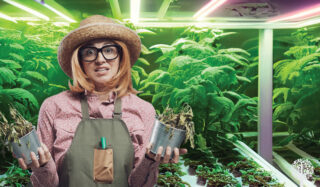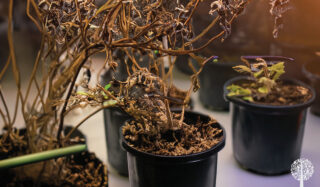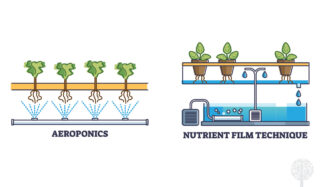Gardening Mistakes Are a Gift to Your Future
We are ignorant creatures, utterly lost in the darkness—so ignorant that we often don’t even know that we don’t know. Take my first foray into indoor gardening, for example. I clubbed with two hapless high school friends to ‘invest’ over $350 in a 400-watt HPS lighting system (complete with a buzzing magnetic ballast, elliptical streetlamp, and comically oversized parabolic reflector). This was back in the age before hydro stores; one of the few solutions available to any budding indoor horticulturist at the time was to send a check to a PO Box advertised in the back of ‘Viz Comic’ and hope for the best.
A few weeks later, the promised lighting system arrived—although we were not sufficiently illuminated to have figured out that we also needed ventilation equipment. As such, we were genuinely surprised when my friend’s wardrobe—the designated space for our communal slice of horticultural heaven—quickly heated up to 100°F. Perhaps mercifully, our “extreme weather project” was abruptly terminated when my friend’s “don’t worry, they’re totally cool” parents first witnessed an otherworldly orange glow emanating from his bedroom door frame and quickly called time on our futile endeavors.
Suffice it to say, we learn by failing—or, theoretically, at least, the offer of a lesson is there. In the years since, I have made so many indoor gardening mistakes that I considered asking Garden Culture if they would commission a series. Alas, all you’ll get here is the briefest summary of my botanical blunders, mishaps, oversights, and brain farts.


Failing to research new growing systems properly has caused me plenty of embarrassment over the years. Once, I comically over-planted two Nutriculture GT-901 NFT systems with a hundred rooted cuttings (fifty in each—and, in case you don’t know, these otherwise super-productive hobby hydroponics systems barely cover a 6’ x 3’4” area (1.8 x 1.0m) each)! Flipping my plants immediately into a 12/12 photoperiod, I thought I was a trendsetter, a maverick, a genius even. I envisaged an ocean of green floricultural paradise emerging over the coming weeks. Instead, the constant irrigation and crowded plant spacing caused extreme stem elongation. It’s one of the few crops that was so appallingly bad that I actually cut it down.
Lesson Learned: Read the manual. Less is more.
Another time, I borrowed a true aeroponics system from a very generous local manufacturer, complete with a powerful air compressor. I think the general idea was for me to grow some photogenic beasts to show off what their incredible growing system could do. The cuttings died in the first few hours. I gave him the system back with no photos.
Lesson Learned: Promise carefully and take time to establish your plants before hitting them with full-intensity light.
But my problems were just beginning. My grow tents suffered from high daytime temperatures in a south-facing room with large windows. Who knew? By this time, I was working with a hydroponics equipment wholesaler, and the boss foolishly agreed that I could help myself to an extraction fan from their warehouse. Naturally, I chose the biggest one I could find. At 12” in diameter, I thought my heat issues were over. Not only did it sound like I was powering up a MiG-29 twin-engine fighter jet in my top-floor apartment, but the only extract port available was in the roof at just 4” in diameter! “No problem,” I thought, “that’s what reducers are for.” So I went from 12 to 10, 10 to 8, 8 to 6, and finally from 6 to 4. What could go wrong?


Lesson Learned: I should have paid more attention in physics class. The increased air velocity, reduced airflow, and massively increased static pressure all conspired to render my new ventilation system very loud and utterly useless.
Moving from soil-based potting mixes to coco coir, I didn’t realize I could get away with smaller pots with a soilless medium. Consequently, I spent way more on growing media than I needed to. Even when I was finally convinced to reduce my pot size, I still didn’t understand the importance of measuring the conductivity of the run-off feed solution. Switching to a 70/30 coco/perlite mix was great for the aeration of my roots, but it increased wet/dry cycles and further exacerbated my rootzone salt build-up issues.
Lesson Learned: When growing in soilless potting mixes, never let your pots dry out, make sure you achieve 30% run-off with each irrigation, and don’t let your plants sit in that run-off!
I recently embarked on an ill-judged side-lighting experiment with light-loving, diecious plants. I bastardized a twin-bar 660W LED commercial top light and fixed it strategically on the walls adjacent to my 4’ x 4’ grow tray. (With sufficient air gaps behind, don’t worry.) However, I failed to account for the dramatic increase in water uptake driven by the additional photons. As a result, my plants quickly became draught-stressed and turned hermaphroditic! Oh, Lord.
Lesson Learned: Increased light = increased transpiration = increased irrigation!
But wait, there’s more. Like the time I started growing hot peppers indoors in the spring, and then the summer arrived. Even with air conditioning, I couldn’t lower nighttime temperatures sufficiently to properly induce flowering. I ended up with some very tall pepper plants and a handful of very expensive peppers.
Lesson Learned: Timing (and temperature) is everything to peppers (and maybe grow them outdoors in the summer, huh?)


In conclusion, the more you learn, the more you realize you don’t know. Wherever you’re at (or think you’re at) on your growing journey, modesty should be your stoical travel companion. Always carefully observe and note as much data as possible, including nutrient strength, formulation daytime and nighttime temperatures, relative humidity, number of days in vegetative growth, pot volume, and irrigation cycles.
Now repeat after me: Next crop, I’m gonna crush it!




